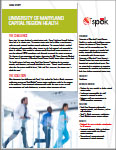Case studies
University of Maryland Capital Regional Health
Overview
University of Maryland Capital Region Health is a not-for-profit healthcare system serving the citizens of Prince George’s County and the surrounding area. The organization’s mission is to provide high-quality, accessible healthcare services in partnership with the community. University of Maryland Prince George’s Hospital Center is an acute care teaching hospital and regional referral center. They are committed to sustaining an innovative environment for providers and students to help them deliver exceptional patient care.
Industry
- Healthcare
Solution
- Operator console, web directory, and on-call scheduling
- Emergency notification
- Secure messaging
Business drivers
- Reduce the time needed to deploy critical patient codes
- Implement accountability for staff required to respond to codes
- Enhance staff communications via HIPAA-compliant messaging
Results
- Reduced the time to deploy critical codes by 50%
- Improved clinicians’ ability to discharge patients more quickly via efficient communications
- Strengthened organization-wide awareness of critical situations
The challenge
Every time her team deployed a critical patient code, Dawn Cole found herself thinking there had to be a better way. The contact center team had to follow a cumbersome, multi-step code protocol involving several applications. The process lacked a method of enforcing staff accountability when it came to who had received and responded to alerts. In addition, Cole needed to enhance overall clinical staff communications in a way that achieved HIPAA compliance and ultimately improved the patient experience. The director of communication and visiting information for UM Prince George’s Medical Center (part of University of Maryland Capital Region Health) began taking a closer look.
The health system had been using Spok Care Connect® solutions for its operator console, web directory, and on-call scheduling for years. “I found myself wondering what else this system could do for us,” Cole said. As it turns out, the answer was “a whole lot more.”
The solution
After discussing her challenges with Spok, Cole realized the Spok emergency notification system and secure messaging application might be the answers to her problems. These integrated solutions would enable the team to amp up staff communications and code deployment, improving patient response and care.
The contact center now uses Spok e.Notify to quickly deploy Code Blues (cardiac arrest), Code STEMIs (heart attack), and Code Strokes, as well as security codes for fires, bomb threats, and active shooters. “I like that the system keeps the data, and we can see who didn’t respond,” Cole said of the accountability and tracking features. “Our Emergency Preparedness team also uses it to send alerts for city-wide disaster codes such as bad weather conditions.
Recently, the team added Code Surge Red and Code Surge Black processes. These “Surge” codes enable the organization to monitor the number of patients in the emergency room at all times, with red indicating an influx of patients and black for when they’re at capacity and may need to divert patients to another location.
These improved emergency notification capabilities integrate with Spok secure messaging, and both pull from the Spok Care Connect web directory and on-call system for up-to-date contact and schedule information. “Caregivers use Spok Mobile to communicate about patient enrollment and discharge. With secure messaging in place, they can now be more specific and add patient information to give the message context,” Cole said, adding that care teams also use secure messaging to share images of patients’ X-ray results. While this method isn’t used for an official diagnosis, it helps get the ball rolling quickly when further analysis is needed to determine treatment.
As a teaching hospital, UM Prince George’s Medical Center welcomes a new group of residents each year, who use secure messaging to communicate with attending physicians. “Residents are tech-savvy and expect to use this kind of technology. We use secure texting to supplement face-to-face communication, but not replace it,” Cole said, pleased that other departments such as nursing and case management will be onboarding soon as well. The goal is to have more areas of the hospital using Spok Mobile to ultimately increase organization-wide awareness of emerging situations through better communication.
Our Spok solutions keep patients from waiting around for decisions to be made.
– Dawn Cole, Director, Communication and Visiting Information
The result
In addition, attending physicians are now able to respond more quickly to patient-related questions from residents, enhancing both staff communications and patient interaction. Clinicians can easily reach one another for final discharge instructions—and comply with HIPAA at the same time. “Our Spok solutions keep patients from waiting around for decisions to be made,” Cole said.
Everyone at UM Prince George’s Medical Center has been happy with the results. “We’re getting codes out in half the time it used to take,” Cole said. “Spok has made our team a lot more efficient and effective, especially when it comes to accountability.”



